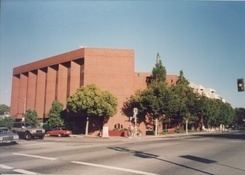Type Search Engine Headquarters Palo Alto, California Website a9.com | Industry Communications Parent Amazon.com | |
 | ||
A9.com is a subsidiary of Amazon.com that develops search engine and search advertising technology. A9 is based in Palo Alto, California with teams in Bangalore, Beijing, Dublin, Iași, Munich, and Tokyo. A9 has development efforts in areas of product search, cloud search, advertising technology and community question answering.
Contents
History
A9 was created by Amazon.com in 2003 as an independent company aimed at producing technology for search and advertising. They moved into the building previously used by the DEC Systems Research Center in Palo Alto, California. One purpose of A9.com was to leverage algorithms, and the name was chosen as a numeronym to represent that word (i.e. 'A' + 9 other letters). The office was in Silicon Valley, near Stanford University. Under the direction of its first president, Udi Manber, A9 focused on several areas, including the A9.com destination website, product search, and a search advertising platform. Some early A9 services such as "search inside the book" continued, while others have been discontinued. The A9 search engine powers product search for Amazon.com and several other eCommerce retailers.
In February 2006, Manber was replaced by David L. Tennenhouse as president. In September 2006, William Stasior, one of A9's founders and a former AltaVista and Amazon.com executive, was named president. In June 2009, A9 acquired SnapTell, which developed smartphone-based visual search applications.
Stasior left in October 2012 to join Apple Inc. and work on Siri. Brian Pinkerton, who had developed WebCrawler in the 1990s, became general manager of A9 in 2012.
A9.com search portal
A9.com originally operated a search portal, along with an A9 toolbar, which was first demonstrated on April 14, 2004. The service featured some innovative design elements, allowing users to choose from over 400 sources to search and view results in separate columns grouped by source. In addition to web search results, users could get product search results from Amazon, encyclopedia results from Wikipedia, movie information from IMDb, and others, starting in September 2004. Web search results were provided by different search engines over time. The search portal functionality was discontinued in 2008.
Open Search
A9 developed a protocol called OpenSearch that enabled the "plug-in" search source functionality from the A9.com portal. The original specification, OpenSearch 1.0, was released in March 2005. A9 made the protocol freely available through a Creative Commons license. OpenSearch is now maintained by the OpenSearch.org community.
BlockView
A9 developed the first service that allowed users of maps and "yellow pages" (a telephone directory) to view buildings at street level. Called BlockView, the service was announced in January 2005. Within a year, the service included images for 24 US cities. Both BlockView and maps (as well as support for the A9 tool bar) were discontinued in September 2006.
Clickriver
In November 2006, A9 announced Clickriver, an advertising program that let third parties place advertisements on Amazon.com pages. Clickriver focused primarily on products and services that complemented Amazon's own offerings. For example, if a customer viewed a television on Amazon, a Clickriver ad might offer installation services in his or her local area. Clickriver was discontinued in 2010, replaced by other Amazon advertising programs.
Community question answering
A9 operated Askville, a community-based question-and-answer site first tested in December 2006. Service began in November 2007. Compared with other question-and-answer sites, Askville focused more on social interaction, allowing users to follow other users as well as track specific topics. On October 25, 2013, Askville was shut down.
Cloud search
CloudSearch is a managed Amazon Web Services service that makes client data searchable. For example, a business that wanted to allow customers to search their catalog could upload the catalog entries to CloudSearch and then route search requests from their application or web site to the service. CloudSearch instances could be brought online as data or traffic volume demanded. Sites using CloudSearch included SmugMug, and Sage Bionetworks.
In March 2014, Amazon moved away from using A9 for CloudSearch to technology based on Apache Solr.
Product search
A9 continued to develop and operate the service that provides search on all nine Amazon.com sites, as well as other retail sites owned by Amazon such as Endless.com, Javari.de, and Audible.com. In addition, A9 search is also used by other retailers, such as Marks & Spencer, that license the Amazon retail platform for their online presence.
A9 provided the "search inside the book" capability for Amazon. Announced in 2003, this service allows customers to search through the full text of hundreds of thousands of books. This feature is available both for searching individual books and for the entire book catalog.
Visual search
The visual search group at A9 created mobile applications that recognize objects and allow users to find these products on Amazon.com. Their first augmented reality app, Flow, provided both object and barcode recognition. It was released in 2011.
A9 visual search technology powers features to let customers search for certain products (such as shoes) by shape, and find visually similar items on Amazon.com, Zappos.com, Endless.com, and other retail sites.
Advertising technology
A9's advertising technology group began delivering sponsored link advertisements on the Amazon.com retail Web site in 2003 and continued to manage this program for Amazon properties. A9 also invests in display advertising technology, including technology for Amazon's ad-supported e-reader, the Kindle with special offers.
